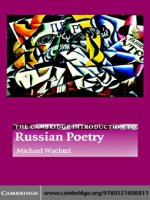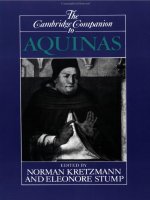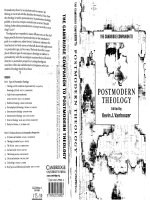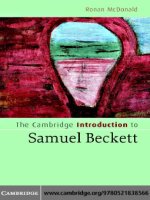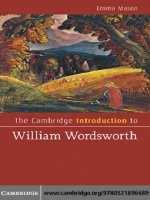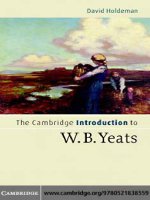The cambridge introduction to postmodern fiction
Bạn đang xem bản rút gọn của tài liệu. Xem và tải ngay bản đầy đủ của tài liệu tại đây (1019.91 KB, 241 trang )
Tai Lieu Chat Luong
This page intentionally left blank
The Cambridge Introduction to
Postmodern Fiction
Postmodern fiction presents its readers with a challenge: instead of
enjoying it passively, they have to work to understand it, to question
their own responses, and to examine their views about what fiction is.
Yet accepting this challenge is what makes postmodern writing so
pleasurable to read and rewarding to study.
Unlike most introductions to postmodernism and fiction, this book
places the emphasis on literature rather than theory. It introduces the
most prominent British and American novelists associated with
postmodernism, from the ‘pioneers’, Beckett, Borges and Burroughs, to
important post-war writers such as Pynchon, Carter, Atwood, Morrison,
Gibson, Auster, DeLillo, and Ellis. Designed for students and clearly
written, this Introduction explains the preoccupations, styles and
techniques that unite postmodern authors.
bran nicol is Reader in Modern and Contemporary Literature at the
University of Portsmouth and has previously taught at Lancaster and
Chichester. He has published on D. M. Thomas, Iris Murdoch,
postmodernism and stalking in contemporary culture.
The Cambridge Introduction to
Postmodern Fiction
BRAN NICOL
CAMBRIDGE UNIVERSITY PRESS
Cambridge, New York, Melbourne, Madrid, Cape Town, Singapore,
São Paulo, Delhi, Dubai, Tokyo
Cambridge University Press
The Edinburgh Building, Cambridge CB2 8RU, UK
Published in the United States of America by Cambridge University Press, New York
www.cambridge.org
Information on this title: www.cambridge.org/9780521861571
© Bran Nicol 2009
This publication is in copyright. Subject to statutory exception and to the
provision of relevant collective licensing agreements, no reproduction of any part
may take place without the written permission of Cambridge University Press.
First published in print format 2009
ISBN-13
978-0-511-64161-9
eBook (NetLibrary)
ISBN-13
978-0-521-86157-1
Hardback
ISBN-13
978-0-521-67957-2
Paperback
Cambridge University Press has no responsibility for the persistence or accuracy
of urls for external or third-party internet websites referred to in this publication,
and does not guarantee that any content on such websites is, or will remain,
accurate or appropriate.
For Karen, Joe and Jamie
Contents
Acknowledgements
Preface: reading postmodern fiction
Introduction: postmodernism and
postmodernity
page xi
xiii
1
Postmodernity and ‘late capitalism’
Baudrillard and simulation
Poststructuralism, postmodernism, and ‘the real’
Sociology and the construction of reality
Jameson and the crisis in historicity
Lyotard and the decline of the metanarrative
Irony and ‘double-coding’
3
4
6
8
9
11
12
Chapter 1 Postmodern fiction: theory
and practice
17
An incredulity towards realism
What postmodern fiction does
How to read postmodern fiction
17
30
39
Chapter 2 Early postmodern fiction:
Beckett, Borges, and Burroughs
50
Samuel Beckett
Jorge Luis Borges
William Burroughs
52
58
65
vii
viii
Contents
Chapter 3 US metafiction: Coover, Barth,
Nabokov, Vonnegut, Pynchon
72
Barth’s Funhouse and Coover’s Descants
Vladimir Nabokov, Pale Fire
Kurt Vonnegut, Slaughterhouse-Five
Thomas Pynchon
75
82
86
89
Chapter 4 The postmodern historical novel:
Fowles, Barnes, Swift
99
Historiographic metafiction
British historiographic metafiction
John Fowles, The French Lieutenant’s Woman
Graham Swift, Waterland
Julian Barnes, Flaubert’s Parrot
103
105
106
112
116
Chapter 5 Postmodern-postcolonial fiction
121
Salman Rushdie, Midnight’s Children
Toni Morrison, Beloved
Ishmael Reed, Mumbo Jumbo
124
127
133
Chapter 6 Postmodern fiction by women:
Carter, Atwood, Acker
140
Angela Carter
Margaret Atwood
Kathy Acker
142
148
156
Chapter 7 Two postmodern genres:
cyberpunk and ‘metaphysical’ detective
fiction
164
Sci-fi and cyberpunk
William Gibson, Neuromancer
Detective fiction
Jorge Luis Borges, ‘Death and the Compass’
Umberto Eco, The Name of the Rose
Paul Auster, City of Glass
164
167
171
173
175
178
Contents
Chapter 8 Fiction of the ‘postmodern
condition’: Ballard, DeLillo, Ellis
184
Conclusion: ‘ficto-criticism’
J. G. Ballard, Crash
Don DeLillo, White Noise and Libra
Bret Easton Ellis, American Psycho
184
186
191
197
References
Index
205
215
ix
Acknowledgements
I would like to thank Ray Ryan of Cambridge University Press for his enthusiasm and patience, colleagues in the English department and in the Centre for
European and International Studies Research at the University of Portsmouth
for their support, and my wife and our boys for their laughter and love.
xi
Preface: reading postmodern fiction
The commonest complaint about the narratives of Beckett or Burroughs
is that they are hard to read, they are ‘boring’. But the charge of boredom
is really hypocritical. There is, in a sense, no such thing as boredom.
Boredom is only another name for a certain species of frustration. And
the new languages which the interesting art of our time speaks are
frustrating to the sensibilities of most educated people.
Susan Sontag, ‘One Culture and the New Sensibility’ (1965)
Sometimes I suspect that good readers are even blacker and rarer swans
than good writers. . . . Reading, obviously, is an activity which comes
after that of writing; it is more modest, more unobtrusive, more
intellectual.
Jorge Luis Borges, Preface to A Universal History of Infamy
(1935) (trans. Norman Thomas di Giovanni, 1972)
In an essay about postmodern fiction a student once declared that Beckett’s
writing ‘doesn’t go down easily’. As I was the marker, I had to point out that
this phrase was not exactly appropriate academic discourse. But I could also
see her point. If reading Jane Austen is like having a nice Sunday lunch, and
The Da Vinci Code is the equivalent of a McDonald’s, then reading Beckett is,
for some, like being asked to complete the ‘Bushtucker Trial’ in the TV show
I’m A Celebrity . . . Get Me Out Of Here.
Besides the parallel between literature and food, her statement implied a
definition of fiction. A novel should be something accessible, easy to read.
Literature should be digestible. But why is this? Why shouldn’t literature be a
challenge to the reader? Who said reading a novel has to be easy? After all, we
accept more readily the fact that modern art, the kind we are confronted with in
the Tate Modern or the Turner Prize, does not communicate straightforwardly,
that we have to work to interpret it. Even poetry, part of the staple diet on
university literature courses, is something we accept from the outset is not
going to give its meaning over to us without a struggle.
xiii
xiv
Preface: reading postmodern fiction
If asked why they read, most people (including myself) would say that
they read fiction for pleasure. It is hard, though, to determine exactly what
the pleasure of reading a novel or a short story is. It may be the pleasure of
escapism, of experiencing what it would be like to be another person, indulging
one’s fantasy-life, or exercizing the intellect. If asked why they choose to study
literature at university, most students reply that it is because they enjoy reading
fiction. (For the kind of reasons just mentioned.) But very quickly they realize
that ‘reading’ literature at university is not simply about enjoying reading. In
fact, for some students, it turns out to be the exact opposite. Many students
feel that the process of studying literature empties reading of the enjoyment
that caused them to study literature in the first place. Why do we have to ask
so many questions about a book? Can’t we just accept that an author wrote
something because he or she felt like it, or wanted to make money?
Postmodern fiction presents a challenge to the reader. This is true even
though most of it is actually not as hard to comprehend as Beckett, and many
of the authors labelled as postmodern (and examined in this book) are among
the most popular, acclaimed, and, I think, enjoyable, writers in contemporary
fiction: Thomas Pynchon, Angela Carter, Margaret Atwood, Toni Morrison,
William Gibson, Paul Auster, Don DeLillo, Bret Easton Ellis.
But postmodern writing challenges us because it requires its reader to be an
active co-creator of meaning rather than a passive consumer. More than this,
it challenges its readers to interrogate the commonsense and commonplace
assumptions about literature which prevail in our culture. Though it is a product of the latter half of the twentieth century, studying postmodern fiction can
deepen our knowledge about literature on a wider scale. To read postmodern
fiction is to be invited to ask: what is fiction? What does reading it involve?
Why do we read? Why, for that matter, do novelists write? Why do they create
innovative, experimental forms rather than just stick to traditional ones?
Postmodernisms
This book is an introduction to postmodern fiction, offering accounts of its
various ‘waves’ in a period stretching mainly from the 1950s to the 1990s and
providing in-depth readings of texts which have been consistently associated
with postmodernism by literary critics and theorists.
Though the term ‘postmodern’ is still an important one in a number of academic disciplines and remains essential in the literary-studies lexicon, the topic
of postmodernism is no longer hotly debated in academic journals and research
monographs. Linda Hutcheon, one of the major theorists of postmodern
Preface: reading postmodern fiction
xv
fiction, has suggested that postmodernism is now, in the twenty-first century,
‘a thing of the past’ because it has become ‘fully institutionalized, it has its
canonized texts, its anthologies, primers and readers, its dictionaries and its
histories’ (Hutcheon, 2002, 165).
This is not quite true, since the conditions of ‘postmodernity’ (as detailed
in the Introduction) still seem to shape the contemporary world, and much
aesthetic and cultural production (novels, film, TV, etc.) still clearly deploys
strategies and generates effects which have been defined as postmodern. And
while it is no longer the subject of cutting-edge academic debate, postmodernism is now more than ever a fixture on literature courses in universities
around the world, and studying it remains one of the most valuable ways of
making sense of contemporary writing.
But there is an advantage to thinking of postmodern fiction as something
effectively in the past, like modernism, something we can treat as a more or
less ‘complete’ historical movement with its own set of core texts (though this
‘teleological’ idea is entirely against the spirit of postmodernism). Now, in
other words, a welcome sense of retrospectivity is possible in relation to the
postmodernism debate.
This book does not seek to produce an exhaustive, exact chronological
survey, taking in every significant writer who has been labelled ‘postmodern’,
but tries to isolate and examine the main varieties of postmodern fiction. My
strategy has been to divide postmodern fiction into groups of authors who
deal with similar questions and favour similar formal techniques. Depending
upon the particular theme, some chapters consider specific authors and offer
readings of one or two or their key works, while others focus on specific
representative texts. The order in which the book considers these varieties of
fiction preserves a loose sense of chronology, though the book is not intended
as a literary history.
The book concentrates mainly on Anglo-American fiction. This means that
some of the non-English-speaking writers who have been convincingly coopted into the postmodern ‘canon’ over the years, such as Alain Robbe-Grillet,
Carlos Fuentes, Italo Calvino and Gabriel Garcia Marquez, are largely absent
from the discussion. This is partly due to spatial constraints, but it is also
because postmodernism has always chiefly been a phenomenon in theory
and criticism produced in England and America and on university literature
courses taught in these countries.
The book, then, attempts to determine what postmodern fiction is – or was –
by looking back at key examples. Its aim is not to provide a final definition of an
entity named ‘the postmodern novel’. This book treats ‘postmodern fiction’ as
a category which contains a number of different kinds of postmodern fiction,
xvi
Preface: reading postmodern fiction
a range of postmodernisms, in fact, rather than alternative ways of expressing a
single, unified postmodernism.
Postmodern fiction is far too diverse in style to be a genre. Nor is it a historical
label, like ‘Victorian fiction’, as to speak of the late twentieth century as the
postmodern ‘period’ would be to misrepresent a great many contemporary
writers whose work cannot usefully be related to postmodernism. I would
prefer to think of postmodern fiction as a particular ‘aesthetic’ – a sensibility, a
set of principles, or a value-system which unites specific currents in the writing
of the latter half of the twentieth century.
To explain this, it is useful to follow the example of Brian McHale (another
major theorist of the postmodern novel) in his approach to defining postmodern fiction, and use the Russian Formalist theorist Roman Jakobson’s concept
of ‘the dominant’: ‘the focusing component of a work of art’ which ‘rules,
determines, and transforms the remaining components [and] guarantees the
“integrity” of the structure’ and which shifts over literary history (McHale
1987, 6).
Identifying postmodern texts is a matter of determining which elements
within them are especially dominant, in this sense. In my view, the most
important features found in postmodern texts are:
(1) a self-reflexive acknowledgement of a text’s own status as constructed,
aesthetic artefact
(2) an implicit (or sometimes explicit) critique of realist approaches both to
narrative and to representing a fictional ‘world’
(3) a tendency to draw the reader’s attention to his or her own process of
interpretation as s/he reads the text
The reason why the concept of the dominant is useful is that none of these
features are exclusive to postmodern fiction. Self-reflexivity is common in the
eighteenth-century novel, modernist fiction rejects nineteenth-century realist
techniques, and a great many novels from all periods invite the reader to
interrogate the reading process. The question is really one of degree. It is also
important to consider how these dominant features correspond to the specific
historical context of postmodernism – in other words, how certain social and
cultural factors have caused them to be more dominant than they are in, say,
modernism.
I should point out that this book contains less about modernism than
perhaps one would expect from an introduction to postmodern fiction. This
is not to deny that postmodernism – as its name clearly indicates – bears a
close relationship to modernism. Many of the most important definitions of
postmodernism, such as those by McHale and Hutcheon, Jameson, Jencks,
Preface: reading postmodern fiction
xvii
and Eco, are founded upon a comparison with modernist values and aesthetic
techniques. In fact, the precepts of modernism will figure in the Introduction
and in Chapters 1 and 2. However, my view is that the starting-point for
understanding postmodern fiction is to compare it chiefly to realism – or
at least the kind of ‘ideal’, ‘straw-target’ version of the nineteenth-century
realist novel, which may not always resemble more complex actual examples
of literary realism but nevertheless has figured as an antagonistic force in the
development of postmodern writing.
Distinguishing between modernism and postmodernism is again a question
of the postmodern ‘dominant’. Patricia Waugh has argued that where modernism is preoccupied by consciousness, showing how the workings of the mind
reveal individuals to be much less stable and unified than realist psychology
would have us believe, postmodernism is much more interested in fictionality
(Waugh, 1984, 14). Fictionality refers to the condition of being fictional, that
is to say, the condition of being constructed, narrated, mediated. Fiction is
always all of these things, which means that the represented world is always
framed, presented to us from the perspective of another. In particular, fictionality involves a concern with the relationship between the language and
represented world of fiction with the real world outside. This is what especially
interests postmodern writers (though an interest is visible in some modernist
texts too) and the reason why they position their writing against realism rather
than modernism is because, in realism, the question of fictionality is generally
ignored or suppressed.
To try and isolate what is effectively a ‘canon’ of postmodern fiction might
naturally lead to disagreement about which authors or texts have or have
not been included. Yet my method is more conservative than it might seem:
I have not tried to incorporate any novelists or texts into the postmodern
tradition who have not seriously been identified as postmodern already by
theorists and critics over the last few decades. To try to keep the discussion
accessible I have offered my own readings of these writers and texts, supported
by relevant theory and criticism, but without being overloaded by references
to the readings of others.
This brings us back to the question of reading. I hope my analyses will be
useful to you in your reading of the postmodern fiction discussed in this book.
I believe the twenty-four novelists it examines are not only twenty-four of the
most important postmodern writers but twenty-four of the most remarkable
novelists in twentieth-century writing as a whole. I hope this book will enhance
your enjoyment of them, making their writing go down a little bit more easily.
Introduction
Postmodernism and postmodernity
There is an episode of The Simpsons in which the barman, Moe Szyslak, tries
to transform his dingy bar into somewhere ‘cool’ and futuristic, decorating
it with randomly chosen objects such as suspended rabbits and eyeballs. His
regulars don’t get it. Faced with their non-comprehending stares, Moe explains:
‘It’s po-mo! . . . Post-modern! . . . Yeah, all right – weird for the sake of weird’
(‘Homer the Moe’, Simpsons Archive).
The Simpsons is widely considered one of the most exemplary postmodern
texts because of its self-reflexive irony and intertextuality. But postmodernism
is not weird for the sake of being weird. Nor is it simply ‘the contemporary’
or ‘the experimental’. It may be ‘avant-garde’ (though many critics, myself
included, think it isn’t), or it may be a continuation of the values and techniques of modernism (but then again it may just as plausibly be a break
with modernism). It may be an empty practice of recycling previous artistic
styles . . . or a valid form of political critique.
Postmodernism is a notoriously slippery and indefinable term. It was originally coined in the 1940s to identify a reaction against the Modern movement
in architecture. However, it first began to be widely used in the 1960s by
American cultural critics and commentators such as Susan Sontag and Leslie
Fiedler who sought to describe a ‘new sensibility’ in literature which either
rejected modernist attitudes and techniques or adapted or extended them. In
the following decades the term began to figure in academic disciplines besides
literary criticism and architecture – such as social theory, cultural and media
studies, visual arts, philosophy, and history. Such wide-ranging usage meant
that the term became overloaded with meaning, chiefly because it was being
used to describe characteristics of the social and political landscape as well as
a whole range of different examples of cultural production.
This begs the question: why has an obviously problematic term continued
to be used? I think the reason is that there has been a genuine feeling amongst
theorists, cultural commentators, artists and writers that our age, has, since the
1950s and 1960s onward (opinions vary as to when exactly), been shaped by
significant alterations in society as a result of technology, economics and the
1
2
The Cambridge Introduction to Postmodern Fiction
media; that this has led to significant shifts in cultural and aesthetic production
as a result, perhaps even (though these are even more difficult to measure)
changes in the way people who exist in these changed conditions live, think,
and feel. To try to capture this sense of change, vague and multi-faceted though
it may be, is why the term postmodernism has been invented, adopted, defined
and redefined.
More precisely, one of the key questions behind the postmodern debate
is how the particular conditions of postmodernity differ from or have arisen
from those of modernity. Theorists have tended to portray modernity (i.e. from
early to mid-twentieth century) as increasingly industrialized, mechanized,
urban, and bureaucratic, while postmodernity is the era of the ‘space age’, of
consumerism, late capitalism, and, most recently, the dominance of the virtual
and the digital. Such generalized portraits of modern and postmodern society
have been paralleled by similar comparisons of the specific aesthetic styles
which have dominated in these periods. Where modernist art forms privilege
formalism, rationality, authenticity, depth, originality, etc., postmodernism,
the argument goes, favours bricolage or pastiche to original production, the
mixing of styles and genres, and the juxtaposition of ‘low’ with high culture.
Where modernism is sincere or earnest, postmodernism is playful and ironic.
The discussion in this book aims to move beyond such generalizations (and,
in any case, after this chapter, will concentrate on prose fiction), but it is
important to acknowledge that the question of how postmodernism relates
to modernism remains a highly contentious one, not least because the term
itself – ‘post-modern’ – implies, confusingly, that modernism has either been
superseded or has entered a new phase.
The problems with the term postmodernism are complicated further
because when reading about it we are actually dealing with three derivatives –
not just ‘postmodernity’, but also ‘postmodernism’ and ‘postmodern’. This latter term gives this book its title and is favoured throughout. ‘Postmodern’ is an
adjective that refers both to a particular period in literary and perhaps cultural
history (though this book is more interested in the former than the latter)
which begins in the 1950s and continues until the 1990s (though inevitably
there is disagreement about this too, as some would argue we are still in the
postmodern period now), and to a set of aesthetic styles and principles which
characterize literary production in this period and which are shaped by the
context of postmodernism and postmodernity. Where ‘postmodernity’ refers
to the way the world has changed in this period, due to developments in
the political, social, economic, and media spheres, ‘postmodernism’ (and the
related adjective ‘postmodernist’) refers to a set of ideas developed from philosophy and theory and related to aesthetic production. To provide a context
Introduction: postmodernism and postmodernity
3
for the discussion in the rest of the book, this chapter will now turn to a
more in-depth consideration of prominent theoretical uses of these latter two
terms.
Postmodernity and ‘late capitalism’
Postmodernity can be described most usefully in terms of the political and
socio-economic systems which develop in what the Marxist thinker Ernest
Mandel called the ‘third stage’ of capitalist expansion (Mandel, 1975).
In the period following the Second World War, the first two stages of capitalism, ‘market capitalism’ and ‘monopoly (or imperialist) capitalism’, were
superseded by ‘postindustrial’ or ‘late’ capitalism. In effect late capitalism sees
the accumulative logic of capitalism extend into every possible area of society, and into every corner of the globe, eliminating any remaining pockets
of ‘precapitalism’. It means that areas of society which were previously unaffected by the logic of the market, such as the media, the arts, or education
became subject to the laws of capitalism (i.e. requiring growth, profits, and
business models) and the advance of what we now call the ‘globalization’ of
consumerism. The result of this is a cultural eclecticism, as summarized in a
much-quoted sentence from the philosopher Jean-Franc¸ois Lyotard: ‘one listens to reggae, watches a western, eats McDonald’s food for lunch and local
cuisine for dinner, wears Paris perfume in Tokyo and “retro” clothes in Hong
Kong’ (Lyotard, 1984, 76).
The key factor behind this expansion, as Larry McCaffrey has argued, is
the rise of technology. As competition is so intense amongst multinational
organisations, it follows that the most important resource of all – more than
actual materials or products – is information which can be used for marketing, research, and production purposes. Ever more sophisticated means
of gathering and analysing information, McCaffrey suggests, has meant that
postmodern society has become increasingly ‘high-tech’, saturated by products
such as medical supplies, weaponry, and surveillance technology (which protects the interests of multinational corporations) and consumer goods such as
mobile phones, computers, plasma screen TVs, high-spec cars, etc.
McCaffrey argues that even more significant than these high-tech products
are ‘the rapid proliferation of technologically mass-produced “products” that
are essentially reproductions or abstractions – images, advertising, information,
memories, styles, simulated experiences’ (McCaffrey, 1991b, 4) and which rely
upon other technologically engineered products such as computers, televisions, digital music, etc. to package and transmit them to consumers. These
4
The Cambridge Introduction to Postmodern Fiction
are much cheaper to produce and consume than more tangible products,
and are the speciality of the advertising, information, and the media/cultural
industries.
The consequence of living in a postindustrial, information-driven, media/
culture-saturated world, according to theorists of postmodernity, is that we
have become alienated from those aspects of life we might consider authentic
or real. While our working lives are still ‘real’ (we go to work and pay the bills)
they are not as real as, say, farming or building a ship. Instead we spend most
of our time at our desks in front of a computer screen processing ‘information’
of one kind or another, engaging with symbolic representations rather than
real, tangible objects. Much of our leisure time is spent engaging in simulated
experiences or consuming more information. Existence has become more
‘virtual’ than real.
Baudrillard and simulation
We tend to think of ‘virtual reality’ in a ‘sci-fi’ sense as an experience to
be available in the near future, once computers are sophisticated enough to
enable us literally to inhabit a fake version of the world but interact with it
as if it were real. It is conventionally imagined (curiously in terms of sadomasochistic fantasy) as a situation in which we don gloves, a helmet, or a suit
and then interact with our real body in a fictional world. But as the postmodern
philosopher Jean Baudrillard has argued, we don’t need to wait for these devices
to be possible: virtual reality is already here, and we all live in it almost every
moment of our lives (Baudrillard, 1994a). We ‘experience’ the world through
TV news or ‘reality TV’ shows, engage with other people we have never met
(in internet chatrooms, or in our fascination with celebrities), use e-mail to
communicate virtually to real people.
Central to Baudrillard’s theory is the idea that we have entered a new phase
of history, though he develops this thesis in a different and rather idiosyncratic
way from Marxist thinkers like Mandel. What characterizes our world is that the
last traces of the ‘symbolic structure’ that reigned in the pre-industrial world are
disappearing. Baudrillard here draws on the economic theory of Marcel Mauss.
Mauss’s famous work The Gift (1953) explores the way primitive society was
founded upon the logic of the gift-exchange rather than commodity-exchange.
Where commodity-exchange is a system that works according to the exchange
of goods for money, gift-exchange involves a threeway system of obligation: the
gift must be given, received, and reciprocated. Most importantly, reciprocation
means effectively giving back more than is received, in order to avoid the
Introduction: postmodernism and postmodernity
5
receiver being placed in an inferior position to the giver and to ensure that the
triangular pattern of exchange may continue (Mauss, 2001).
In early societies this logic underscored every aspect of life, from harvest
festivals to military service to weddings, and meant that even people could
be gifts. Where Mauss believed that remnants of this economy still operate
in our own money economy (e.g. weddings, dinner parties), though they
have largely been replaced by a formalized notion of commodity-exchange,
for Baudrillard this form of symbolic exchange has died out completely. Now
there is only the endless and meaningless exchange of signs, which are even
less ‘real’ and more ambiguous than commodities or currency (often they are
images or words): everything can be exchanged for everything else, every sign
is potentially interchangeable, reversible. There is no surplus element as there
was in symbolic exchange.
Baudrillard’s term for this overall interchangeability of signs is ‘the code’.
Its function is to ‘codify’ reality according to the ‘law of value’. In other words
it establishes a system of signs which provides (or tries to provide) everything
with a meaning and a value relative to other things. It establishes the binary
oppositions upon which Western culture is founded (life over death, good
over evil, cause over effect) and produces an apparent stability in essences,
identity, difference, and meaning. In this way the code actually produces reality:
we experience the world through the sign-system of values set down in its
underlying metaphysic.
The special ability of the code is to duplicate things so that the copy is indistinguishable from and indeed replaces the original. It is visible in science (in
biology or DNA) and in computer and information technology which enables
perfect reproduction (e.g. of biological tissue or of a photographic image).
Previously, copying something that is real resulted in a version of the real thing
which was still recognizable as a copy. Yet because the code can produce an
exact replica, the difference between the original and the copy is eliminated.
This effect is a typical one in contemporary culture which is characterized by
a process of reproduction Baudrillard terms simulation. He points to numerous instances in the contemporary world in which the ability to distinguish
between the real and representation is compromised: for example, Disneyland,
opinion polls, President Nixon, Michael Jackson. Perhaps the most powerful
example is the way that the actual events of twentieth-century warfare have
become replaced by their representations: we ‘consume’ the representations as
if they are real. The Vietnam War, the Gulf War, even, retrospectively, the Holocaust, are visible only in simulated form: with Vietnam, Baudrillard argues, ‘the
war became film, the film becomes war, the two are joined by their common
haemorrhage into technology’ (Baudrillard, 1994b, 59).


